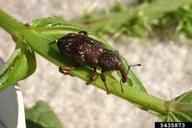
Hylobius transversovittatus (Purple Loosestrife Root Weevil) is a weevil (family Curculionidae), native to Eurasia. It was introduced to North America as part of a biocontrol program for the wetland plant Purple Loosestrife (Lythrum salicaria), which is now widespread in North America and considered a problematic invader. This program, under the auspices of the Agricultural Research Service of the United States Department of Agriculture (USDA-ARS) and the United States Fish and Wildlife Service (USFWS), began with a study of insect herbivores which control L. salicaria in Europe. Four species of beetles, including G. calmariensis, G. pusilla, Hylobius transversovittatus, and Nanophyes marmoratus were released in freshwater wetlands across the United States, with the intention of attacking the leaves, roots and seeds of the plant. Larvae of Hylobius transversovittatus feed on the roots of Purple Loosestrife, and take 1 or 2 years to mature. Adults create a chamber in the upper root, and emerge at night to mate and lay eggs at the base of the plant. This weevil can tolerate brief, but not prolonged, flooding. Over 100,000 eggs and larvae of H. transversovittatus were released in at least 30 states and 3 provinces, including wetlands in Chesapeake Bay, Delaware Bay, the Hudson River, Connecticut River, the Columbia River and Coos Bay, and were released in many smaller wetlands, too. The underground habits of the weevils have made their establishment and impacts difficult to assess, however, they are considered established at many locations. The goal of the Purple Loosestrife biocontrol program was not eradication, but reducing the dominance of L. salicaria and restoring diversity in wetlands, and is considered largely successful.